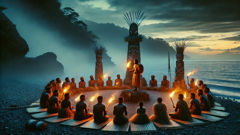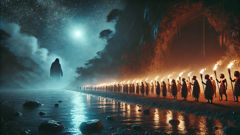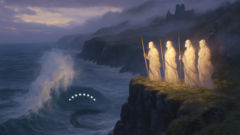Introduction
Far before the names we use now were carved into the soft wood of canoes and before the songs that elders hum by firelight had rhythm, there was a sea so wide it seemed to swallow the sky. From that sea rose Qat, who arrived with a laugh like thunder and hands that remembered how to shape islands. The air in those days was thick with possibility; the horizon trembled as if listening. Qat moved like a thought — quick, clever, not yet weighed by the sorrow that comes with knowing how things end. He coaxed reefs upward with the tip of his finger, whistled coral into gardens, and hummed rivers into remembering their courses. Where Qat walked, shells turned into stones that became hills, and the hills settled into islands with mangrove hair and volcanic spines. Yet even as life opened under his touch — the first breadfruit trees, the shy glow of shellfish, the bright cheek of the first bird — another presence roamed the shadowed channels and the deep fissures under rock. Marawa was the name of that presence, a long and hungry thing who loved silence: not the restful silence of sleep, but the hollow, final silence that takes breath away. Marawa tasted endings the way other creatures taste salt; it drifted into hollows and gathered the last light as if collecting coin. The world that Qat shaped was destined to be a place of songs and stories, but it would also be a place where endings would be sung by Marawa. Thus begins the oldest telling: how Qat, maker of islands and laughter, learned the cost of care, and how he bound a part of that cost to the dark so that living things could go on.
Qat Raises the Islands
Qat’s first hands knew the language of the sea. He learned it not by reading, but by listening — to the way waves sighed against reef and the way the deep kept its own counsel. Once Qat pressed his palms flat to the water and sang a low, rolling song that sent currents bending like grass. Where his voice touched, coral rose and settled into curves that caught the tide. An island is nothing without edges, he thought, and taught the sea to make them. The earliest days were busy and joyful. Qat carved channels for rivers from his thumb, and the rivers answered by carrying the island’s first soil inland. He coaxed the volcano’s breath into gentle mounds, and when the mountain exhaled, ash turned to rich earth. Birds came before people, and their first cries stitched the sky into constellations that would later guide canoes. In those mornings Qat watched shells hatch and learned their names, and when a new shell glinted he set it upon the sand like a gift.

The people came later, pulled ashore by curiosity and by Qat’s invitations. They came in small canoes, their paddles cutting bright lines through the water. Qat showed them how to build houses from pandanus and how to weave fish traps from flexible vines. He taught them that the world must be shared, that seed and net and story must pass from hand to hand. He molded the first kava bowl, and they drank in the hush after its passing like a promise. Under Qat’s teaching, the people learned to name what they loved: the coconut’s slow sway, the breadfruit’s generous weight, the way pigs honed the edges of the earth with their always-hungry snouts. Qat laughed then, and his laughter became part of the island wind.
But creation is never only bright. Qat felt, like the first thundercloud, a rumble in his chest: a sense that shaping required not just giving life but containing some ending. Marawa had been there since before the islands were fixed — a shadow with teeth and a patient manner. When Qat first noticed Marawa, the spirit slid across the sand like spilled ink, touching the tender crowns of seedlings and leaving a hush. Marawa did not kill for cruelties’ sake; it had a taste for finality. A crab that had been alive in the morning might be ghost-quiet by noon if Marawa had passed. It was not violent in the roaring way of storms; it worked like frost, a slow and sure taking that left the world colder in small places.
Qat hated Marawa for the hush it left. And yet he understood the balance that the island world needed: if everything remained forever green with the first pulse of life, there would be no room for renewal, no space for seed to fall and rewrite the soil. Qat sat with the elders of the sea and the deepest roots and learned the rules of measure. He learned to shape not only to create but to carve ways for endings to live less together with beginnings. He did this not to banish Marawa — the world would have none then — but to keep the spirit’s hunger from spreading like an unmarked storm. Qat’s first bargain with the shadow was simple: he would teach the people how to remember names and songs so that a passing being could not take what had a voice. In return, Marawa’s hunger would be limited to those who had completed their path, those whose breath had waned naturally and whose stories were ready to be parted from the living. This bargain was fragile, held together by song and by ritual, by the small ceremonies the people performed for the dead: offerings left at the reef edge, songs carried into caverns, and the slow marking of graves under festivals of taro. The bargain worked only as long as the people kept the songs alive. The moment memory became thin, Marawa grew bold.
As islands grew, so did the intricacies of life. Qat shaped lagoons where children would later learn to dive, and he scattered stones to form pathways that led between villages. He braided cliffs with vines so that goats and houses would find footings, and he cupped basins that became freshwater springs. He also placed thresholds — small, careful markings — where Marawa should not pass, woven from names and words that the people would learn to speak when the moon was right. Qat taught the sculptors to carve faces into doorposts, not as fantasy but as active remembering: the eyes of a carved ancestor could call back a wandering life that the shadow had nearly taken. For a time, the islands hummed with balance. The people grew fat with fruit and song, and they learned to welcome the tide of seasons.
Yet Marawa’s patience was long and its cunning was older than coral. It learned how to listen for the thinnest reprimands, the soft webs where memory had frayed. Where the people forgot a name, Marawa would slip thither and take what remained of a life that had been overlooked. Sometimes Marawa reached beyond the bargain and gathered small things — the last light in the eye of a child who had been ill, the breath from a fisher who had misread the sea — and in doing so taught the island people the weight of their promise. After a string of such losses, the villages came to Qat and asked him to do more than instruct: they demanded he bind the hunger to narrower bounds. Qat, who had created with laughter, then created with sorrow. He gathered basalt and sun-heat and the last threads of his patient songs and wove them into a long cloak that could hold the shadow at bay. He taught to the people new songs, darker and keener, songs that were not for partying but for standing guard. Those songs were hard to learn: they required named lists — of children, of elders, of seed-bearing trees — and the repeated recounting of small, important deeds that kept memory fresh. For generations, the people maintained the balance. They carved memory into posts and painted shapes into canoe hulls and held careful feasts so Marawa would find the island a place to take its rightful measure and no more. But balance is always a practice, not a place, and the story goes on.
In the end Qat knew that he was not a ruler to command the world into perfection but a guardian who must teach the living how to stand. His hands, once only generous, acquired a steadiness that kept the islands from tipping into too-much or too-little. Sometimes, when the tide was low, villagers could see Qat on a distant spit of rock, patience folded about him like the cloak he had made. He would be counting the stars and singing the names he had told them to sing. When Marawa found a place where the names had not been said, it pressed there like a bruise, and Qat would go with a wave and mend the wound. That mending is what gave rise to ritual: the palms pressed together in grief and gratitude, the communal weaving of memory that turns the final hush into a circled moment of handing over rather than a theft. In this way the islands remained alive: because memory was lived, because endings were given shape.
Marawa’s Hunger and the Covenant of Remembering
Marawa had been born of night and deep fissures before Qat had scooped the first basin for a spring. The spirit was neither wholly malicious nor easily pitied; it existed to remind the living that endings must be honored. Still, Marawa’s method left the living raw: it took without leave, and its touch turned bright things to husks. Stories describe Marawa as a long mouth that slides through the world collecting last breaths like seeds. In some tellings Marawa resembles a sea creature with too-many eyes, each blind with lack; in others it is only a wind that passes through reed huts and leaves the hair of the sleeping people unruffled. Who or what Marawa was matters less than what it does: to take what life cannot easily give again. When a village grew careless — neglecting the names that kept the covenant whole — Marawa learned to move like a slow tide, patient and irresistible. It found the places where grief had been locked away like an ember, where a son’s forgetting of his father’s name left a small, dangerous aperture. Crossing that aperture, Marawa would ease in and finish what the living had not yet been ready to finish.

The people could not drive Marawa away with force; fire and spear did little to it. The weapon against the spirit was the very thing Marawa used to feed: memory. A name spoken aloud, a song repeated at the proper moon, a ritual feast offered for the dead — these were the sharp edges that could close a breach. Qat taught the islanders precise ways to remember: lists uttered at dawn, carved posts singing names in the wind, patterns woven into mats that told whole family histories. When memory was practiced and insisted upon, Marawa’s hunger respected the lines of bargain. It took as agreed: those who had finished their stories, whose endings were ready, whose breath had thinned with the season. Marawa’s taking then was not theft but an ordered crossing. The spirit’s presence cut the world into two necessary motions — the moving-in of life and the moving-out of life — and the people learned to mark both with a steady hand.
Rituals became the island’s architecture of remembering. On certain nights the elders lit fires at the reef edge and called out the names of those who had slipped away in the last moon, and the light and the song made the border between living and gone as clear as a reef-line in low tide. Canoes were painted with the faces of ancestors to remind paddlers they carried the past across the water. Food was offered at thresholds, not to placate a ravenous thing, but to ensure that Marawa’s taking was a blessed passage rather than a sudden absence. In the same way Qat had set thresholds in the land, the people set thresholds in their practice: knots in rope that represented remembered promises, tattoos that mapped genealogies, and shared feasts that told stories out loud so that no life could vanish slackly into silence.
There were times when the bargain was strained. A drought could take root in a village and thin its population; grief could scatter names like leaves. In those moments Marawa smelled possibilities where it had previously found only ritual barriers. It would press its hunger into the weak seams — a hut with no watch, a grave with no song laid upon it — and the people would find themselves bereft in ways that shook their belief in Qat’s protections. These were the stories that elders used to frighten the young into carefulness: a child who refused to learn the names would find the fish slipping from the net; a man who sold his land and forgot the posts would wake to find his pigs gone silent. Those stories were not only scare-tales; they were instruction manuals in a metaphoric sense. The moral was clear: to live on a Qat-shaped island was to live responsibly toward endings. You were not only the bearer of your own life but a steward for the words that would hold the lives of others.
Qat was not content to let the covenant be carried only by the frail hands of memory. He devised devices of binding: symbolic knots and clay seals, small altars that the people could renew easily. He showed them how to craft masks whose faces could hold names in carved lines, and these masks were used at ceremonies to accept passing souls. He also taught them the labor of tending communal spaces where memory was made public — like planting groves where the story of a lineage was retold each year as the trees bloomed. That public nature of remembering mattered: when memory was communal it could not be allowed to grow lazy. A single forgotten name could be picked up by neighbors like a pebble and polished back into meaning. Qat’s brilliance lay in making memory practical and social rather than private and easy to lose.
Sometimes, though, even the best practices could not prevent grief. There are mythic episodes where Marawa’s appetite surged beyond its bounds, where the shadow found a secret passage and carried away a beloved child or a wise elder. Those losses bent villages into themselves, and Qat would appear then — not as the bright creator laughing with the sunrise, but as a figure carved from concern. He would re-cement the thresholds and sew new songs into lives. Often Qat’s work began with listening: he would walk with a grieving family, watch them perform the old rites, and then add a new verse or a new small object to their remembering so that the lesion the shadow had opened would not be an easy place for future hunger. In this way the myth teaches that healing is repetitive and lovingly incremental. Each stitch of remembrance makes the island stronger, and each story told aloud keeps Marawa honest and limited.
In the telling of the island, Marawa remains part of the weave. The spirit’s hunger is a dark thread that gives the bright colors shape and contrast. The people’s songs, the carved posts, the rituals at the reef — these are their answer. They are not tricks to erase death, for death will always come, but ways to make endings into crossing-places where the living can still recognize what was and what was given. As long as the islanders keep Qat’s lessons — as long as they speak the names and pass them down around dancing fires — the bargain holds. Marawa still moves in the world, but it moves with rules, and those rules are the people’s responsibility. The myth closes its circle here not with a final triumph but with a daily practice: a reminder that creation requires not only hands that give, but also hands that remember and honor the places where endings come to rest.
Conclusion
Generations later, when the wind carries the scent of breadfruit and the sea slides silver under the moon, the story of Qat and Marawa is still told. It is told not as a finished epic but as a living instruction: make, sing, remember. Qat’s hands are said to have softened over time, but his care endures in the carved posts and in the woven mats where genealogies are stitched in repeating patterns. Marawa is not slain in the tale; to slay the shadow would be to unmake the world that depends on endings to clear space for beginnings. Instead, the story preserves a covenant, a fragile and beautiful balancing act where the people themselves must carry the work. They bring offerings to reefs, they teach children names, they paint canoes with ancestors’ faces and build altars of tide-wet stones. In doing these things they keep Marawa honest and let Qat’s islands remain places of rain and laughter. The myth endures because it is a practical map for living in a world shaped by hands and by hunger, and because it asks a question of every listener: will you learn to remember? In answering yes — by singing, by carving, by telling the story anew — each generation renews the old bargain and keeps the island from unmaking. That is the lasting wisdom: life is beautiful because it is finite, and the rituals that honor endings are the very stitches that hold life intact.


















